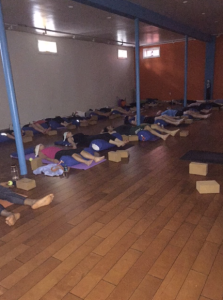
Yoga's Safe Haven (Savasan-ahhhh!) – Corpse Pose "Death of the Ego"
By Mandy Lubas, OTR/L, RYT, AWC
Savasana, a sanskrit word meaning corpse, is that juicy pose that is looked forward to at the end of each yoga practice. It is the most important pose of a yoga practice because of what it serves the student physically, spiritually, and mentally. All of the practices that we do in yoga, from an opening mantra (a word or phrase repeated over and over again), pranayama (breathing exercises), meditation, the physical practice, to the end at Savasana is what I consider the “Circle of Life.” It is all a metaphor for Life. When we are welcomed into this world out of our mother’s womb we take our first breath (pranyama), followed by a mantra “a cry”, and then taking a pause to integrate the experience through the nurturance of “touch” by our mothers or surrogate, then back to savasana (relaxed state) nestled in a fetal position in a crib.
What’s happened to my mind, body, and soul on my yoga mat needs to be integrated somehow. Therefore, Savasana is a time for me to go “within” to integrate all the movements and the teachings (yogic philosophy) deep into the muscles and the cellular memory of my body. So much happens in this 5-7 minute pause of re-connecting back to me to re-birth a “New” for a new day. For the yoga teacher, this is a sacred time, a time when a space is held for the students while they are in a state of deep relaxation. This quiet time holds so much for the student as this is a time to relax, restore, and nourish the spirit.
I like to share some evidenced based practice around Savasana and its physiological benefits. People “rant and rave” so much about this pose, but do student’s really know why this pose is essential to longevity? Do student’s really understand why they may have releases (i.e. crying, muscle twitching, feel hot or cold sensations, hear a message through a visual or auditory experience, etc…) while in this pose? Below are some key points that I’d like to address to provide you with some clarity or perhaps to gain insight.
Theta Brain Waves
The physical asana practice is designed to quiet the fluctuations of the mind “citta vritti.” Therefore, allowing the mind to be quiet to surrender into stillness. Since this is a critical time in the yoga class, the room is usually gifted with music that taps into the “theta” waves of the brain (vibrating at 4-8Hz “cycles per second”) which appear during meditative, drowsy, or sleeping states, but not during the deepest stages of sleep. Tapping into a theta state gives a surprisingly powerful boost to intuitive work and the ability to access the subconscious mind. Goal achievement also becomes much easier and a more efficient process. Theta brainwaves correspond to a state of mind associated with dreams and waking dreams, as well as a deep meditative state. They are slower than the Beta and Alpha activity we normally have in daily life. Theta states are normally responsible for those “Eureka!” moments of well known inventors and scientists. In addition, chanted mantras such as a repeated “OM”, crystals, healing bowls, and chimes can be incredible for deepening a student into corpse pose.
Physiological Benefits
Easing the mind through deep relaxation causes many physiological benefits and this is all taking place through this “integration” period of going inward while supine (on your back), and being all propped up.
After the exertions of the practice, Savasana allows the body a chance to regroup and reset itself. After a balanced practice, the entire body will have been stretched/lengthened, contracted, twisted and inverted. This means that within 5-7 minutes even the deepest muscles will have the opportunity to surrender by “letting go” to shed away the conditioned thoughts that are stored in the student’s anatomy and physiology from their regular habits. The physiological benefits that the student reaps from this deep relaxation are numerous and include:
- a decrease in heart rate and the rate of respiration.
• a decrease in blood pressure.
• a decrease in muscle tension.
• a decrease in metabolic rate and the consumption of oxygen.
• a reduction in general anxiety.
• a reduction in the number and frequency of panic attacks.
• an increase in energy levels and in general productivity.
• an improvement in concentration and in memory.
• an increase in focus.
• a decrease in fatigue, coupled with deeper and sounder sleep.
• improved self-confidence.
Why Practice Corpse Pose (death of the ego)?
The reason is for mastery over death. This is a metaphor for the death of our identity, the “ego.” This is not quite easy, but the practice of yoga is the transformation of the self. Yoga teaches students to let go of what we hold to be true about ourselves and life and choose to not know what we are or what life is all about. The reason lies in the fact that death brings us face to face with total destruction of the self. The practice of yoga is ultimately the transformation of the self. This transformation leads us to greater and greater states of aliveness and awareness by having little identity deaths, glimpses of not identifying with our mind chatter. We are the only living thing on Earth that knows we are going to die. Every moment of every day we are one day closer to death. And how we normally deal with death is by avoiding it in ourselves and with our loved ones. Yoga teaches the opposite path. The path is to let the layers of fear and desire that keeps us hostage to our egos to be dissolved. Easier said than done, but it can occur through courage and practice.
The next question is what is life all about? Life to me is living my dharma (my life purpose), however to get to this mind set, one must surrender to the life that they have planned for themselves and embrace the life that is simply unfolding. You must be willing to get out of your own way! Have you ever met someone who has looked death in the face and have come back fully alive? This is because they have mastered death and experienced pain while on that journey by asking questions such as: Have I wasted my life away by not following my path? Did I make an impact in the world? Was I compassionate enough to others? Did I live each moment to its fullest?
They have come back wiser and reconditioned to what is rather than focusing on their fears and desires. They are now tuned into who they truly are. They have discovered their life dharma. Why wait until we have a near death experience to live life to the fullest? Destruction of the self is the access to the experience of yoga. Giving up our beliefs is so terrifying and fear is a necessary stage in self-discovery. The practice of Savasana is surrendering to our conditioned thoughts and realizing we are not our thoughts or our minds. If we become the witness of these thoughts than we are on to something. We are just the witness witnessing incessant mind chatter that is consuming all of our energy that could be available for the “I” to shine through. I invite all of you to ponder upon this and perhaps be the witness of that running record that may be pushing you further away from living a life from the heart!
Mandy Lubas, OTR/L, RYT, AWC is a Holistic Occupational Therapist certified in sensory integration and Certified Panchakarma Technician, who has been in the field of medicine for 13 years. She treats individuals in homes, schools, the community, outpatient clinics, a studio called Ananda Shanti Yoga and Wellness Center, and an integrative medical practice called Well Life Medical, where she combines traditional medicine with Yoga and Ayurveda. Mandy is a graduate of Quinnipiac University, Kerala Ayurveda Academy, and Yogaspirits® 200, 800, and 1000-hour teacher training programs, and is currently working toward her certification in Craniosacral Therapy. She can be contacted at [email protected] or www.holistictherapies4life.com.







Leave a Reply